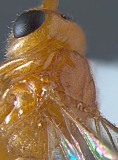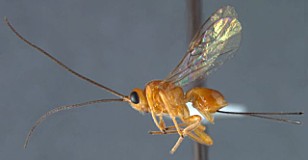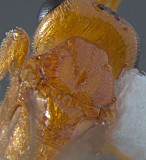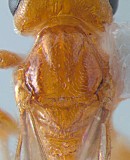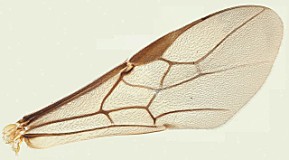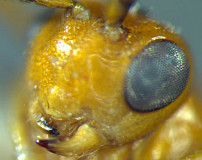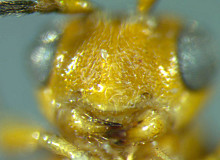Diachasmimorpha fullawayi (Silvestri, 1913)
Taxonomic History / Nomenclature
This species was originally described by Silvestri (1913) as Diachasma fullawayi.
Silvestri (1913) also proposed the variety robustum for larger individuals that he reared from fruits collected in Conakry, Guinea.
Silvestri (1913) also proposed the variety robustum for larger individuals that he reared from fruits collected in Conakry, Guinea.
For additional information, see the Diachasmimorpha page. In publications prior to about 1988, the species of Diachasmimorpha, including this one, were most often placed either in the genus Opius or in the genus Biosteres.
Diagnosis and Relationships
Diachasmimorpha fullawayi differs from the other Afrotropical species of Diachasmimorpha by the absence of carinate sculpture on the second metasomal tergum. However, this sculpture is sometimes only weakly developed in males of these other species. A more definitive character for identification is the presence of two small median teeth along the apical margin of the clypeus in Diachasmimorpha fullawayi. (An alternative way of looking at this character is as a weak median indentation giving the appearance of a small tooth on either side.) These may be difficult to see (see translucent part of clypeal margin in Fig. 7), but are otherwise diagnostic for this species.
Additional morphological features of use in distinguishing Diachasmimorpha fullawayi from other members of the genus are: 1) the fore wing 1cu-a is not as widely separated from 1M; 2) the lateral margin of the mesonotum between the notaulus and tegula is more distinctly carinate; 3) the notauli are often weakly sculptured basally; and 4) the first flagellomere is slightly shorter than the second.
Distribution
Diachasmimorpha fullawayi is widespread in the Afrotropical Region, where it has been recorded from Senegal to Nigeria in the West, across Congo to Kenya, and recently reported from Reunion (Wharton et al. 1999, 2000; Vayssieres et al. 2002).
Distribution
Native
Kenya (Fischer, M. 1972.; Fischer, M. 1959.; Papp, J. 1985.; Gilstrap, F. E. and Hart, W. G. 1987.; Bianchi, F. A. and Krauss, N. H. 1937.; Bianchi, F. A. and Krauss, N. 1936.; Le Pelley, R. H. 1959.; Lopez, M.; Sivinski, J.; Rendon, P.; Holler, T.; Bloem, K.; Copeland, R.; Trostle, M.; Aluja, M. 2003.)
Senegal (Back, E. A. and Pemberton, C. E. 1918.; Brues, C. T. 1926.; Canovas, C. 1940.; Delucchi, V. 1957.; Silvestri, F. 1939.; Fischer, M. 1963.; Fischer, M. 1972.; Fischer, M. 1959.; Waterhouse, D. F. 1993.; Papp, J. 1985.; Gilstrap, F. E. and Hart, W. G. 1987.; Silvestri, F. 1914.; Silvestri, F. 1913.)
South Africa (Laing, J. E. and Hamai, J. 1976.)
Introduced
Australia (Thompson, W. R. 1953.; Fischer, M. 1972.; Fischer, M. 1959.; Turica, A. 1968.)
Hawaii (Back, E. A. and Pemberton, C. E. 1916.; Back, E. A. and Pemberton, C. E. 1918.; Bess, H. A. 1953.; Pemberton, C. E. and Willard, H.F. 1918.; Smith, H. S. 1929.; Willard, H. F. 1920.; Willard, H. F. and Mason, A. C. 1937.; Willard, H. F. 1930.; Willard, H. F. and Bizzell, T. L. 1930.; Thompson, W. R. 1953.; Fischer, M. 1972.; Fischer, M. 1959.; Waterhouse, D. F. 1993.; van Zwaluwenburg, R. H. 1937.; Gilstrap, F. E. and Hart, W. G. 1987.; Bess, H. A.; van den Bosch, R.; Haramoto, F. H. 1961.; Mason, A. C. 1932.; Bennett, F. D.; Rosen, D.; Cochereau, P.; Wood, B. J. 1976.; Haramoto, F. H. and Bess, H. A. 1970.; Pemberton, C. E. and Willard, H. F. 1918.; Wilson, F. 1960.; Laing, J. E. and Hamai, J. 1976.; Clausen, C. P. 1978.; Eitam, A. 1998.; Bodenheimer, F. S. 1951.)
Puerto Rico (Fischer, M. 1972.)
Biology / Hosts
This species has been reared from various ceratitine tephritids, and readily develops on medfly, Ceratitis capitata, both in the lab and in the field. Medfly is a native host of this species in Kenya (Wharton et al. 2000).
Biology and Behavior
Detailed information on the biology of this species was published by Pemberton and Willard (1918a), Pemberton and Willard (1918b), and Back and Pemberton (1918), shortly after it was introduced to Hawaii by Silvestri (1914).
Biological Control
Diachasmimorpha fullawayi was successfully introduced to Hawaii, where it was one of several species providing satisfactory control of medfly in some crops (Willard and Mason 1937). It was last recorded from Hawaii in about 1949 (based on specimens I have examined), and has not been seen since despite extensive sampling programs for tephritid parasitoids there.

